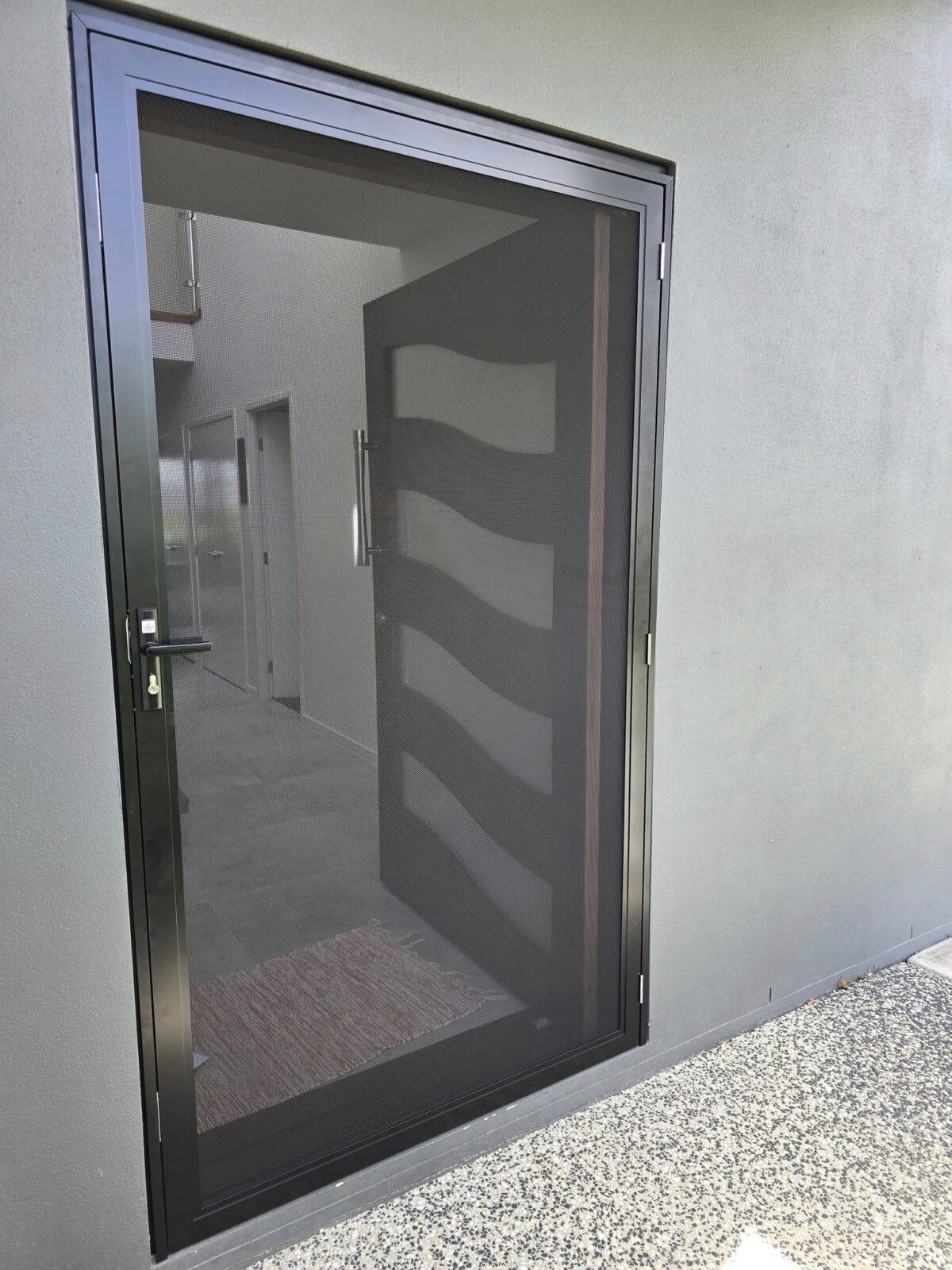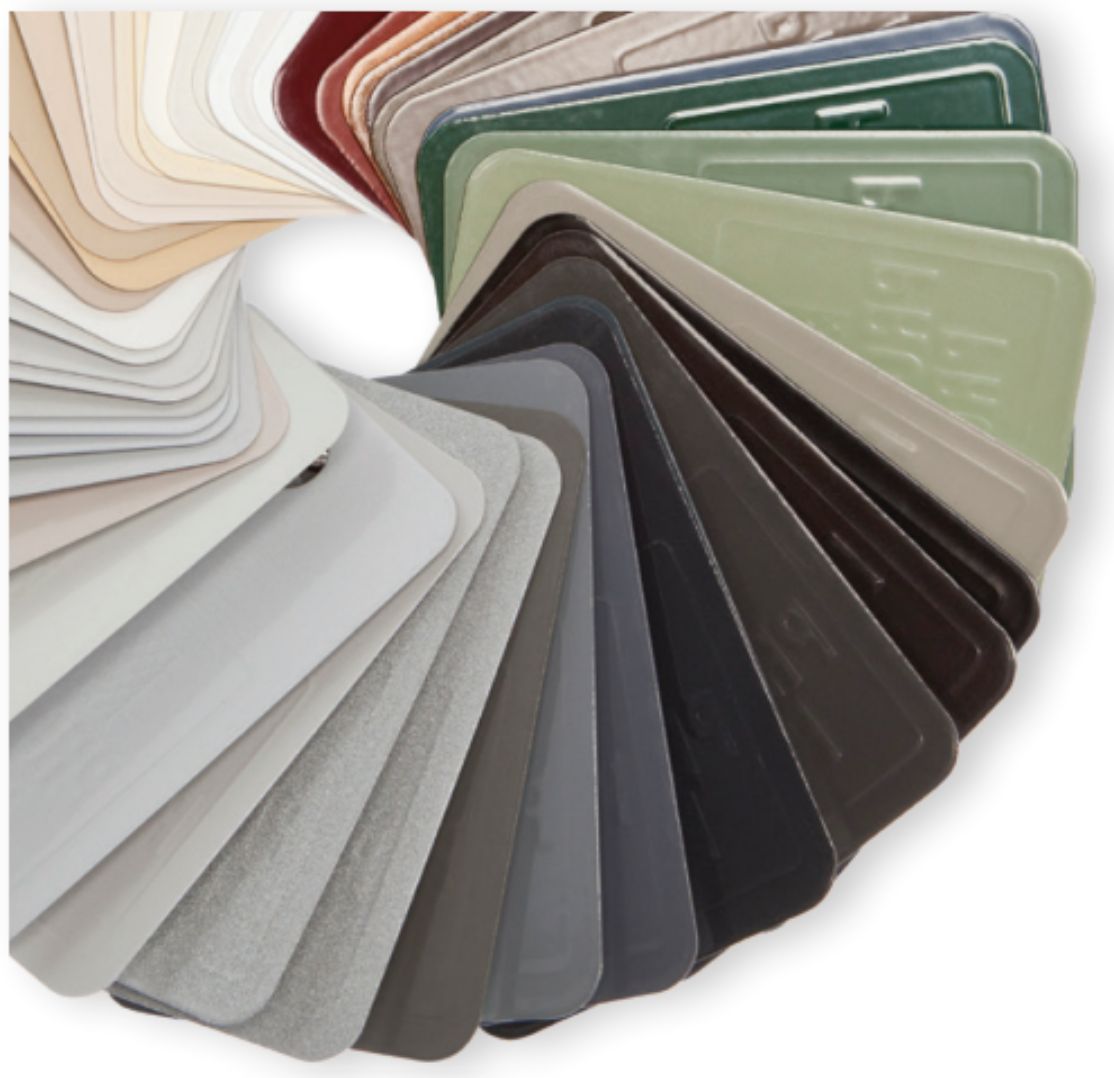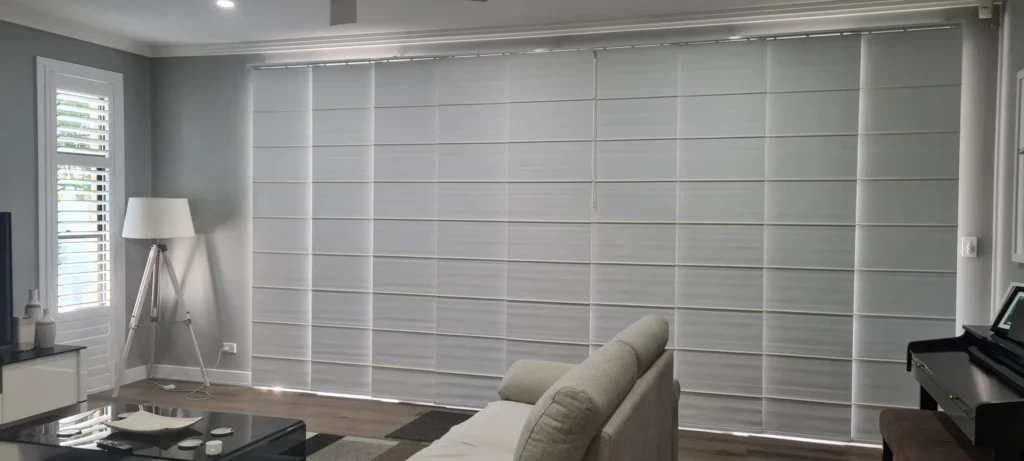
Key Factors to Consider Before Selection
Understanding Usage Patterns
Before choosing sliding door blinds, evaluate how the door functions in your home’s layout. Does this sliding door or patio door serve as the primary access to your yard, pool, or patio? Or is it a secondary entrance that receives minimal traffic?
High-use sliding doors require window treatments that:
- Move smoothly without interfering with pathways
- Consist of durable components that withstand frequent operation
- Can be quickly repositioned when passage is needed
For doors with constant traffic, prioritise solutions offering straightforward operation and unobstructed access. Panel configurations and vertical systems are great for high-traffic areas in these situations.
Light Management and Temperature Control
Sliding doors can create challenging light conditions affecting comfort levels throughout your home. Glass panels receiving direct sunlight benefit from coverings with effective thermal properties. Roller blinds with insulating fabrics can help reduce energy expenses by minimising heat transfer.
If your sliding door overlooks attractive landscaping or views, consider treatments that balance light control with visibility. Well-designed blinds not only protect against direct sunlight but also shield interiors from UV damage while preserving furniture from sun-related deterioration.
Privacy Requirements
Privacy considerations heavily influence blind selection for large sliding glass doors. Consider whether your patio doors face public areas, neighbouring properties, or a secluded yard, as each situation demands different levels of seclusion.
During daytime hours, sheer fabric may provide adequate privacy while preserving natural light. However, at night, when interior lights are activated, more opaque solutions prevent visibility from outside. Light-filtering fabrics deliver moderate privacy with brightness, while complete blockout fabric offers maximum seclusion, ideal for bedrooms or areas requiring total privacy.
Available Space
Prior to finalising your sliding door blind selection, measure the available space surrounding your sliding doors, as different styles require varying installation clearances. For recessed mounting, verify sufficient depth within your door frame (vertical systems require a minimum 33mm depth, with 84mm being optimal).
Consider the accumulation space required when blinds are fully opened. Vertical slats and panel blinds need lateral clearance to stack, while roller blinds store compactly at the top of the door. In limited spaces, roller blinds or externally mounted options generally work most effectively.
Top Blind Options for Sliding Doors
Roller Blinds
Roller blinds excel in providing a clean, minimalist design. They retract into a neat cylinder above your doorway, perfect for spaces where you wish to avoid visual complexity. The thing about roller blinds is that they’re both practical and stylish for modern interiors.
A single roller blind accommodates widths up to 3 metres, while linked configurations can extend to 6 metres. This makes them adaptable for wide sliding doors. The linking mechanism employs specialised intermediate brackets to join multiple blinds while maintaining a cohesive appearance.
Since roller blinds move vertically rather than horizontally, you’ll need to raise the entire blind to access the door. These work best in locations where door access is infrequent or when you install separate units for different door panels. Two blinds are often used on sliding doors to allow easy access to outdoor areas without sacrificing privacy.
The fabric options for roller blinds are virtually unlimited. From sheer fabric that filters light while preserving views to total blockout fabrics offering maximum privacy and light control, roller blinds can be customised to meet specific requirements. Roller blinds are made with quality materials that ensure durability and performance.
For sliding doors exposed to direct sunlight, consider sunscreen fabric that reduces temperature transfer while maintaining visibility. Many homeowners select dual roller configurations combining a sunscreen blind for daytime use with a blockout layer for nighttime privacy.
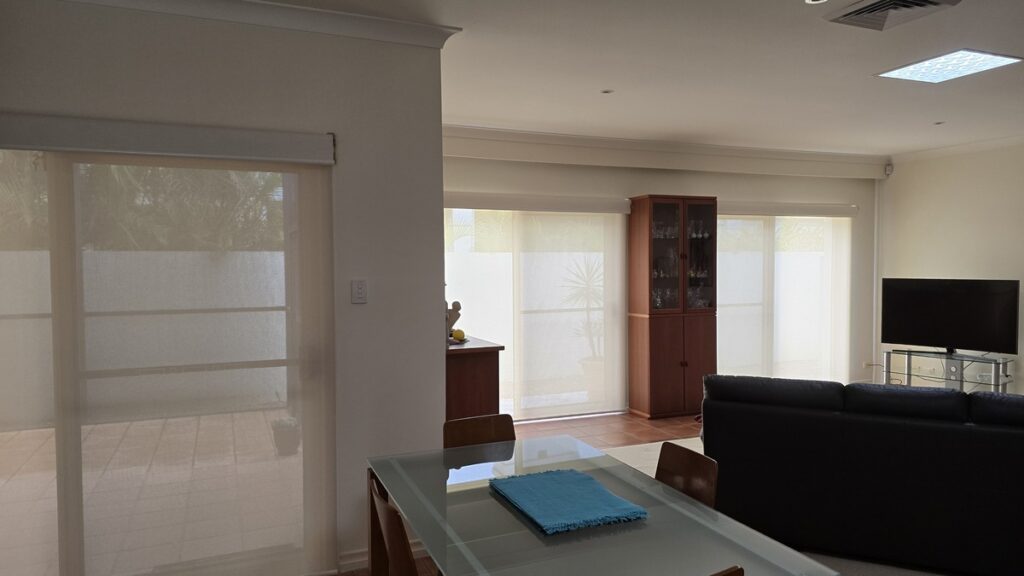
Vertical Blinds
Vertical blinds remain popular for sliding doors because their design complements the door’s movement direction. These systems can cover impressive widths. A single unit extends up to 5.5 metres, making them suitable for even the largest door openings.
The standout feature of vertical blinds is their adaptability. They stack efficiently to one side when not required and allow slat adjustment for precise light and privacy control. This permits you to block harsh sunlight without completely darkening your interior.
Contemporary vertical blind fabrics have evolved significantly from earlier versions. They now feature modern materials and textures that enhance any interior design scheme. Regardless of your decorative preferences, these blinds provide:
- Adjustable privacy levels
- Uncomplicated operation using wand or cord controls with child safety features
- A design that visually increases perceived ceiling height
- Excellent value compared to many alternative options
Modern vertical fabrics offer impressive patterns, textures, and colour selections to complement any décor. Configuration options include left or right stacking, centre opening, or centre closing functionality. The vertical slats can be angled to permit filtered light, manage privacy, or completely closed for maximum seclusion.
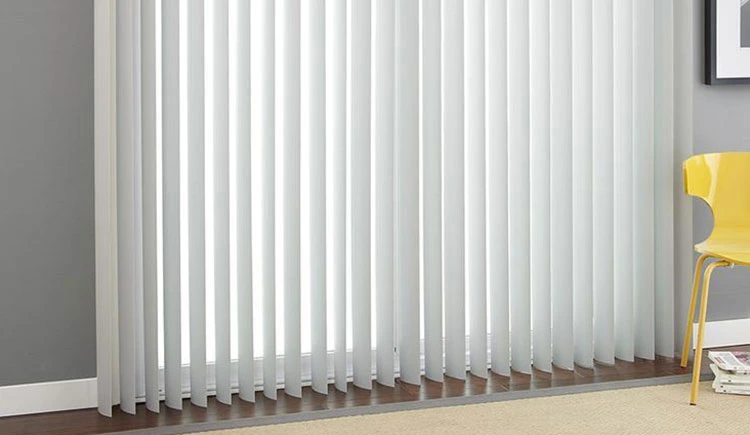
Panel Glide Blinds
Panel glide blinds represent an evolution of vertical blind technology. They feature wider vertical panels creating a sleek, contemporary aesthetic. The panels glide smoothly on tracks and stack neatly, providing clear views and unobstructed door access.
These blinds work exceptionally well for sliding doors due to their user-friendly operation. The large vertical panels create a clean, modern appearance, and the track system allows efficient storage when opened. The flat fabric sections move easily thanks to simplified headrail mechanisms with glider-mounted carriers.
Panel configurations typically include 2-10 large fabric panels that overlap when closed. Available options include light-filtering, sunscreen, or complete blockout materials to provide exactly the light control and privacy required.
One significant advantage of panel blinds is their versatility in frequently used areas. You can partially extend them to maintain some privacy while still allowing door access. This makes them particularly suitable for sliding doors serving as main entry points to outdoor spaces. Similar to panel glide systems, sliding panel options are great for large sliding doors.

Plantation Shutters
Unlike blinds, plantation shutters are solid window coverings that provide a high-end solution for sliding doors. These architectural features add significant value to your home while excelling at both light management and privacy control. Despite being a different category of window treatment, they deserve consideration alongside traditional blind options for sliding door applications.
Modern sliding plantation shutters come in multiple configurations:
- Bypass Track Design: Panels glide on separate tracks, allowing stacking or overlapping for light control
- Bi-fold Configuration: These fold accordion-style, with hinged sections that stack laterally when opened
Your room’s layout should guide your selection. Bypass designs function better in limited spaces, while bi-fold shutters provide complete access but require more operational clearance.
Shutters for sliding glass doors offer several advantages, including exceptional durability, superior insulation, increased property value, timeless appeal, and minimal maintenance requirements. While they represent a higher initial investment, their longevity often makes them cost-effective over time. They complement traditional home styles and perform well in challenging environmental conditions.
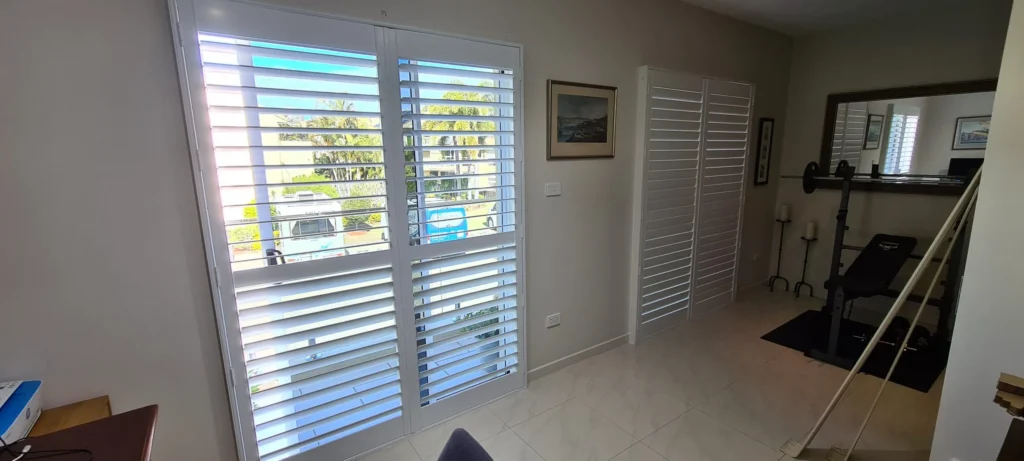
Sheer & Blockout Curtains
Sheer and blockout curtains provide versatile options for sliding doors, either as standalone treatments or combined with blinds and shutters. Sheer curtains filter light while maintaining daytime privacy, creating an airy atmosphere. Blockout curtains deliver complete privacy and light control, with insulating properties that help regulate interior temperature.
When used together, they offer exceptional flexibility. Use sheer curtain panels during daylight hours and blockout curtains at night, or layer them for visual depth. For sliding doors, S-fold or wave fold styles stack compactly without obstructing access. Mount curtain rods higher and wider than the door frame to create the impression of larger doors and ensure curtains can be fully retracted.
While requiring more space than some blind options, curtains add softness and acoustic benefits that can transform your sliding door area into a design focal point. When deciding between blinds or curtains for your patio and sliding glass doors, consider both practical needs and aesthetic preferences.

Room-Specific Recommendations
Living Areas
Living rooms with sliding doors need window treatments that balance light management and privacy while supporting indoor-outdoor connectivity. Light-filtering fabrics work well in these spaces, with popular options including sheer curtains, sunscreen materials, and panel blinds offering adjustable privacy and light control.
Panel systems excel in these areas as they can be partially extended while maintaining door access. For open-concept spaces, select treatments that completely clear doorways when opened, such as vertical blinds or panel tracks, ensuring unobstructed movement during gatherings.
Bedroom Spaces
Bedrooms featuring sliding doors require solutions prioritising sleep quality and light control. Blockout materials provide complete privacy and protection from early morning sunlight, essential for restful sleep environments.
Blackout blinds create total darkness even with expansive glass doors, blocking UV rays and helping maintain comfortable room temperatures. For doors accessing private outdoor areas, consider dual-function options like split roller systems or panel blinds that permit occasional exterior access while maintaining privacy.
Kitchen and Dining Spaces
Sliding doors in kitchens and dining areas need practical treatments that withstand heavy use and potential food-related splatters. Faux wood, vinyl, and aluminium blinds offer moisture resistance and easy cleaning with simple wipe-down maintenance.
Vertical blinds function particularly well for dining areas with sliding doors, as the slats can be angled for optimal lighting during meals and resist food residue accumulation. Roman blinds can also be a stylish option when used on sliding doors that aren’t frequently accessed. For these active spaces, prioritise durable materials that maintain appearance despite frequent cleaning.
Maintenance and Longevity
Regular maintenance extends blind lifespan, with different materials requiring specific cleaning approaches. Fabric blinds respond well to mild detergent and lukewarm water (below 30°C), while wooden venetian blinds should avoid moisture exposure. PVC and aluminium blinds tolerate more thorough cleaning with standard household cleaners, but always ensure complete drying before raising any blinds to prevent mould development.
Quality blinds, properly maintained, can last 7-10 years or longer. For sliding door blinds in high-traffic areas, periodically lubricate mechanisms and inspect tracking systems for debris accumulation. Watch for indicators of wear, including frayed cords, operational difficulties, warped slats, or faded fabric, and consider replacement when repair costs approach replacement value.
Transform Your Sliding Doors with Screen and Blind Master
For Gold Coast residents looking to enhance their sliding doors with quality window treatments, Screen and Blind Master offers comprehensive solutions tailored to our unique Queensland climate. Our family-owned business specialises in premium custom-made blinds designed to withstand coastal conditions while complementing your home’s style.
We understand that choosing the right blinds for sliding glass doors can be challenging, which is why we provide:
- Free measure and quote service for both residential and commercial properties
- Expert guidance on the best window covering options for your specific needs
- Professional measurement and consultation with no obligation
- Precision installation by qualified technicians who are easy to operate
- Comprehensive manufacturer’s warranties for peace of mind
From beachfront properties to suburban homes throughout the Gold Coast, our team has professionally installed thousands of blinds that perfectly balance functionality with style. Contact Screen and Blind Master today for a free in-home consultation to discover how our blind solution can transform your sliding glass doors with beautiful, practical window treatments.
Frequently Asked Questions
What blinds work best for sliding doors?
Your lifestyle should guide your sliding door blind selection. Active families with children and pets typically benefit from durable vertical blinds or panel tracks that complement the door’s movement direction. Those prioritising aesthetics might prefer the clean lines of roller blinds or the premium finish of plantation shutters.
Consider how you utilise the window or door throughout different seasons. Summer activities might favour options that fully retract without impeding indoor-outdoor movement, while winter comfort might prioritise insulating properties. The right blinds for sliding doors balances your practical requirements with design preferences.
How can I enhance my sliding glass door’s appearance?
Consider your sliding door as a framed view rather than merely a functional element. Create a layered approach with both practical and decorative components, perhaps combining functional blinds with decorative side panels. Use contrasting colours to emphasise the doorframe, or match coverings precisely to wall colours for a seamless appearance.
Don’t overlook the surrounding area. Position furniture to create natural flow toward the door, add indoor plants that complement the exterior view, and ensure evening lighting enhances rather than detracts from the glass. These contextual elements can dramatically improve how your sliding door integrates with your living space.
How to cover sliding glass doors for privacy?
Privacy needs often fluctuate throughout the day. Morning light might be welcome while evening exposure feels intrusive. Consider dynamic solutions like double rollers that transition from sheer daytime privacy to complete blockout as needed. Top-down/bottom-up configurations allow light from above while maintaining privacy at eye level.
Remember that lighting affects privacy. When interior lights are on at night, even translucent coverings may not provide sufficient privacy and light control. Strategic options include automated systems that close at sunset or zoned coverings that protect only the most visible areas while preserving views elsewhere.
Should you install curtains over sliding doors?
Curtains offer unique benefits that hard window treatments cannot match. They provide sound absorption, draft reduction, and a softness that complements hard architectural elements. They work particularly well in spaces where you want to create visual warmth or where acoustics matter, such as media rooms adjacent to outdoor areas.
The installation technique significantly impacts functionality. Consider traverse rods for smooth one-hand operation, recessed ceiling tracks for a clean contemporary look, or decorative rods with stylised finials as design features. The hardware becomes part of your décor, so select these elements with the same care as the fabric.

